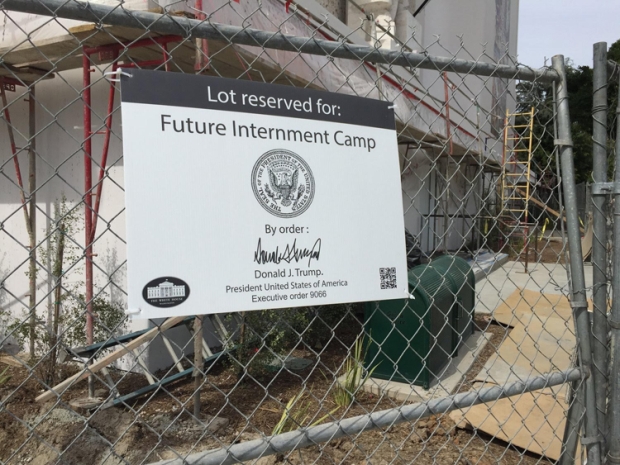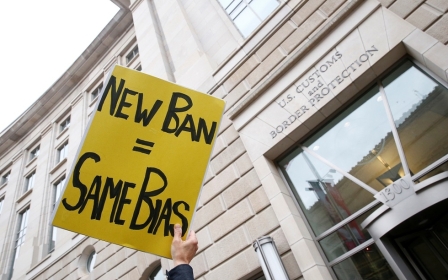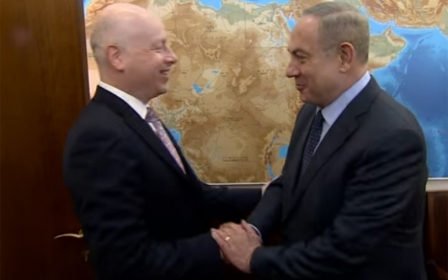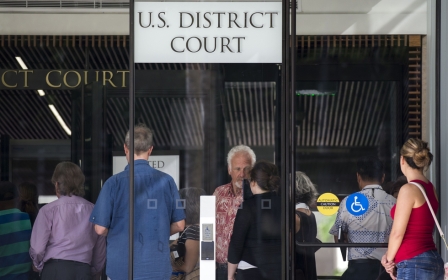Street art challenges Trump in wake of travel ban, arts cuts

WASHINGTON, DC – Earlier this month, a suspiciously credible-looking sign citing a “future internment camp” and bearing President Donald Trump’s signature and official seal went up around undeveloped areas in nine cities across the US. They even contained the number of an executive order, albeit one signed by President Franklin Roosevelt to round up Japanese-Americans.
The signs caused a stir on social media, with one Twitter user calling them “the real fake news,” and another asking, “Is this clickbait? I can’t tell what’s real anymore.”
Authorities removed most of the signs within a few days.
Alongside the traditional activism of occupying public spaces and disrupting speeches in response to Trump's travel ban and other policies, street artists have responded with bold, provocative projects to highlight what they see as the transgressions of a fear-mongering administration – and the impact is palpable.
“I never expected these to stay up for long. The street art that I do is street art for a social media age,” the artist behind the project, identified as Plastic Jesus, told Middle East Eye. “What is important to me is the way in which they get shared.”
“There was that consideration that they could in fact be real signs, which is concerning. We seem to be sleep-walking into a very dangerous outcome,” he said.
The project began five weeks ago, but “from the time I came up with the concept, to the time we executed it, it seemed almost less and less bizarre,” the LA-based artist added, referring to the chaotic rollout of Trump’s initial ban on citizens and refugees from seven Muslim-majority countries.
After a second attempt at a travel ban and a budget proposal that ends funding for creative arts entities in favour of larger immigrant detention centres, Trump this week vowed to press on with his controversial campaign promises in spite of a sustained resistance by targeted communities since he took office.
Plastic Jesus, a self-described “European” who holds a green card, spent 20 years as a photojournalist and covered part of former president Barack Obama’s 2012 campaign before turning to street art. He insisted he’s still doing photojournalism, “but my medium’s changed”.
The current administration’s attack on news media and threats to First Amendment and minority rights is “actually outrageous,” he said.
“We can’t let this become normal behaviour, or a normal process in a democratic republic,” Plastic Jesus said. “The signs were intended to shock people… so they’ll hopefully question their beliefs about what is acceptable in society now.”
Muslim community afraid
The shock value isn’t lost on Sahar Shafqat, a local organiser with the DC Justice for Muslims Coalition, which brings together multiple activist groups to combat Islamophobia.
Shafqat told Middle East Eye that while the “powerful” signs make the same point that Muslim civil rights activists are trying to make, she has her concerns.
“The demonisation of Muslims which has occurred in the United States… specifically by the Donald Trump camp, is terrifying,” Shafqat told Middle East Eye. “It’s opening the door to… violent possibilities. This piece of art makes that point.”
But “precisely because we’re in a moment in which this actually doesn’t seem that far-fetched, the fear I have is that this would really scare a lot of [people]. The fear is already so high among the Muslim community that it is not helpful to ramp up that fear even more,” she said.
Brian Andrew Whiteley, a New York-based artist, tried to turn that fear around last year when he installed a tombstone in Central Park bearing the name of the then-presumptive Republican nominee, along with an epitaph that read: “Made America Hate Again.” The stone was quickly removed by the parks department and confiscated by police.
The fear is already so high among the Muslim community that it is not helpful to ramp up that fear even more
- Sahar Shafqat, DC Justice for Muslims Coalition
Trump was “giving people a green light to be openly racist… an act of domestic terrorism, if you will,” Whiteley told Middle East Eye. “I wanted to find a way to speak more directly to him, in a way, and to make him visualise what he will be remembered for.”
Though it bore no death date, right-wing groups labelled the installation a death threat, Whiteley said, and soon the Secret Service was conducting an investigation in his home.
“I had to release mental health records and… run down a list of questions: if I ever owned a gun, if I’d ever been to rallies, what types of books I was reading… you name it,” he said.
Whiteley maintains that his artistic protest was worth it, describing it as “cathartic,” and “gruesomely poetic”.
“I was never a politically focused artist,” he noted. “With Trump, everyone I know is shifting gears as an artist… [There is] an urgency and immediacy of action.”
Trump's budget proposal eliminates the arts
Organisations across the creative arts community have waded deep into the political sphere in recent weeks, most of them sharply criticising the president’s policies.
In a statement, PEN America, which is dedicated to supporting and defending literary culture, slammed the administration for the “aggressive interrogation of artists and writers” – many of them citizens of Western, US allies - by US Customs and Border Protection officials.
“America’s status as a world-class cultural hub, as a proponent of free thought and lively debate, as a country that celebrates our diversity and welcomes new voices and new ideas from all corners of the world, is crumbling,” the organisation said.
It’s plainly clear to many of us in the creative community that it’s not just a budget thing
- Brian Andrew Whiteley, artist
Meanwhile, the National Endowment for the Arts, a US federal government agency that Trump plans to eliminate, released a statement on Thursday saying it is “disappointed” in his 2018 budget proposal. The agency provides grants for everything from musical theatre to visual arts and design.
“It’s plainly clear to many of us in the creative community that it’s not just a budget thing,” Whiteley said. “It’s a drastic shift in fairness, correctness, it’s really scary. It’s a slippery slope.”
“Art and artists are revolutionaries in their own way,” Shafqat affirmed. “Art makes people think in ways that traditional activism doesn’t. It touches people in a way that traditional activism does not. And I think art also has incredible ability to create new possibilities.”
New MEE newsletter: Jerusalem Dispatch
Sign up to get the latest insights and analysis on Israel-Palestine, alongside Turkey Unpacked and other MEE newsletters
Middle East Eye delivers independent and unrivalled coverage and analysis of the Middle East, North Africa and beyond. To learn more about republishing this content and the associated fees, please fill out this form. More about MEE can be found here.





